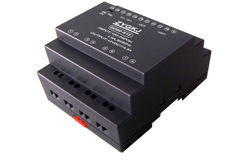nouvelles
AC-DC Power Supply: Ensuring Reliable and Efficient Conversion of Electrical Power
Auteur: Module d'alimentation ZYG Time: 2023-6-19
An AC-DC power supply is a device that converts alternating current (AC) into direct current (DC). This conversion process is essential for many electronic devices to function properly. Power supplies are used in a variety of applications, from powering consumer electronics and computer systems to industrial machinery and medical equipment. They play a crucial role in ensuring reliable and efficient conversion of electrical power.
The process of converting AC to DC involves several stages. The first stage is rectification, which involves converting the AC voltage to an equivalent DC voltage. This is typically done using diodes, which are electronic components that allow current to flow in one direction only. The resulting DC voltage will be pulsating and need smoothing by a capacitor filter.
The second stage is regulation, where the DC voltage is stabilized to a constant level. This is necessary because the output voltage of the rectifier will vary with changes in the input voltage and load. The regulation stage uses a feedback loop to adjust the output voltage to the desired level by comparing the actual output voltage to a reference voltage. This can be done using a variety of techniques, including linear regulation, switching regulation, and pulse-width modulation (PWM).
Linear regulation is the simplest and most traditional method of power supply regulation. It uses a series pass transistor to control the output voltage. The transistor adjusts the voltage drop across it to maintain a constant output voltage. However, this method is not very efficient as the excess voltage is dissipated as heat.
Switching regulation is a more efficient method of power supply regulation. It uses a switching transistor to rapidly switch the DC voltage on and off. This creates a pulsed voltage that is then smoothed by a filter capacitor. The duty cycle of the switching transistor is controlled by a feedback loop to maintain a constant output voltage. However, this method can generate electromagnetic interference (EMI) due to the switching action.
PWM regulation is a hybrid of linear and switching regulation. It uses a high-frequency switching transistor to pulse the DC voltage on and off. The duty cycle of the switching transistor is controlled by a feedback loop to maintain a constant output voltage. This method is more efficient than linear regulation and generates less EMI than switching regulation.

In addition to rectification and regulation, power supplies also often include additional features such as overvoltage protection, undervoltage protection, and current limiting. These features ensure the safety and reliability of the power supply and the equipment it is powering.
In conclusion, an AC-DC power supply is a critical component in many electronic devices and applications. Its ability to convert electrical power from AC to DC and regulate the output voltage is essential for reliable and efficient operation. The choice of rectification and regulation methods depends on the specific requirements of the application, with linear, switching, and PWM regulation being the most common. Additional features such as overvoltage protection, undervoltage protection, and current limiting further enhance the safety and reliability of the power supply and equipment.
les informations pertinentes
-
2023-7-12
Exploring the World of Electric Power: An English Language Series
Introduction: Welcome to the captivating world of electric power! In this English language series, we will embark on an exciting journey to uncover the mysteries and wonders of electricity. From its discovery to its practical applications in various fields, join us as we delve into the realm of electric power. Chapter 1: The Discovery of Electricity The journey begins with the discovery of electricity. We will learn about the key figures who played significant roles in unraveling this fascinating phenomenon. From Benjamin Franklin's famous kite experiment to Alessandro Volta's invention of the electric battery, we will explore the milestones that paved the way for our modern understanding of electricity. Chapter 2: Understanding Electric Circuits In Chapter 2, we will delve...
Voir les détails -
2023-7-5
Bidirectional DC-DC Converter: An Efficient Solution for Power Conversion
Introduction: Power conversion plays a crucial role in various applications such as renewable energy systems, electric vehicles, and energy storage systems. The bidirectional DC-DC converter has emerged as an efficient solution for power conversion due to its ability to transfer power bidirectionally between two DC voltage sources. This article aims to explore the working principle, advantages, and applications of bidirectional DC-DC converters. Working Principle: A bidirectional DC-DC converter consists of two unidirectional converters, namely the buck converter and boost converter, connected back-to-back. The buck converter steps down the input voltage, while the boost converter steps up the voltage. These converters are controlled by a high-frequency switching mechanism that allows energy transfer bidirectionally. During the step-down mode, the buck converter operates...
Voir les détails -
2023-6-3
Exploring the functionality and advantages of bidirectional converters
In today's world of electronics, the need for efficient power management is rapidly increasing. With the growing demand for renewable energy sources, bidirectional converters have become a crucial component in energy storage systems, electric vehicles, and microgrids. Bidirectional converters are devices that can convert DC power into AC power and vice versa. They are designed to be able to transfer power in both directions, making them highly versatile and essential in applications that require efficient power management. Bidirectional converters can be classified into two types: AC-DC and DC-DC converters. AC-DC converters are used to convert AC power to DC power, while DC-DC converters convert DC power to DC power. The main advantage of bidirectional converters is their ability to transfer...
Voir les détails -
2023-5-8
AC-DC Converter Module: A Power Conversion Solution
AC-DC converters are power conversion modules that convert the alternating current (AC) voltage from the mains supply into a direct current (DC) voltage that can be used to power electronic devices. These converters are commonly used in various electronic applications as a means of power supply. The AC-DC converter module is an integral part of many electronic devices, including computers, mobile phones, and home appliances. It is used to convert the AC voltage from the mains supply into a DC voltage that can be used to power the electronic components of these devices. The module is designed to be compact, efficient, and reliable, making it ideal for use in a wide range of applications. The AC-DC converter module consists of...
Voir les détails -
2023-9-20
DC to DC Power Supply Module: Empowering Your Devices with Efficient Energy Conversion
Introduction: Electronic devices have become an integral part of our lives. From smartphones to laptops, tablets to smartwatches, these devices require a constant and efficient power supply to function optimally. This is where DC to DC power supply modules play a crucial role. By converting one DC voltage level to another, these modules ensure that devices receive the power they need to operate effectively. In this article, we will explore the importance and benefits of DC to DC power supply modules in empowering our devices with efficient energy conversion. Efficiency in Energy Conversion: One of the primary advantages of using a DC to DC power supply module is its ability to convert energy efficiently. These modules are designed to minimize...
Voir les détails -
2023-9-11
AC Power Supply Module: Delivering Reliable and Efficient Electrical Power Solutions
Introduction Electrical power is an essential requirement for almost every aspect of our lives. From powering our homes and offices to supporting industrial operations, the need for reliable and efficient electrical power solutions has never been greater. One key component that plays a crucial role in delivering this power is the AC Power Supply Module. This article will explore the importance of AC Power Supply Modules and how they contribute to providing reliable and efficient electrical power solutions. What is an AC Power Supply Module? An AC Power Supply Module is an electronic device that converts alternating current (AC) power from an electrical outlet into a stable and regulated direct current (DC) power output. These modules are commonly used in...
Voir les détails


















